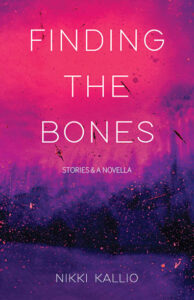Halloween Haunts: How a favorite holiday (Hint: It’s not Halloween) made me love spooky stories
by Nikki Kallio
When my collection of short fiction came out this year—an assemblage of sci-fi, speculative and gothic stories—a family member who read the book commented that she liked it, but she thought it was really dark. “Have you always been this dark?” she asked.
It got me thinking—have I? When was it that I began to appreciate stories that reach into the shadows, whether they take place in a creepy house or outer space?
The answer: Christmas.
While there’s a long and crimson-wrapped tradition of Christmas-horror films, some early influences—not all intended as horror—helped develop my adoration for spooky tales.
It’s a Wonderful Life (1946).
Director Frank Capra’s direction is often associated with sentimentality—and there is plenty of that—but this film also was my first introduction to parallel universes and alternate realities; a first inkling into the magic, possibility and horror of speculative fiction.
In the film, the character George Bailey, played by Jimmy Stewart, weathers a long series of disappointments in his life, eventually believing his death (and resulting life insurance payout) would be more valuable to his wife, Mary, and their family.
George is spared from suicide by the oddball angel Clarence, who jumps from a bridge into an icy river to prompt George to rescue him. As they warm up in the pilot house, George suggests that it simply would have been better if he’d never been born.
Clarence, being an angel, makes it happen.
George and Clarence traverse the now-unrecognizable town of Bedford Falls, renamed “Pottersville” for the evil tycoon who has bought out everything. George gains a view of life in the failure of his father’s modest building-and-loan, which had kept the town’s everymen housed and employed.
The effects of George’s absence are everywhere. An old employer has gone to prison; George learns in a graveyard visit that his brother died as a child because George wasn’t there to save him from drowning. In turn, a World War-II ship full of men died because George’s brother wasn’t there to save them. And it goes on.
There’s some cringeworthiness that interrupts the film, including the Mary-becoming-an-old-maid-and-spending-her-life-as-a-librarian-bit (OH THE HORROR THAT’S THE WORST THING THAT COULD HAPPEN), but overall the sequence is terrifying. George’s own mother doesn’t know him, the previously sweet townspeople are now darkly hostile, the scenes overall are shadowy and barren. George wants to know what happened to Mary, and, now careening directly toward insanity, he chases her down the street like a stalker.
And of course, being a Frank Capra film, it all turns out fine in the end; a tale of living your life and trusting all will be well. Not a standard horror ending, but it’s the interstitial scenes of George’s mounting terror that I love.
Incidentally, Saturday Night Live once sketched a more horror-appropriate alternate ending that’s worth a look. (https://www.youtube.com/watch?v=vw89o0afb2A)
Rudolph the Red-Nosed Reindeer (1964)
This stop-motion Rankin/Bass classic television special just has a bizarre aesthetic, like broken dolls or mid-century Halloween costumes. It’s a classic holiday staple that also inspired the look for the 2003 Will Farrell film Elf, which apparently even ran into legal trouble over the costume resemblance.
(https://www.looper.com/297081/the-real-reason-will-ferrells-elf-almost-never-happened/)
In the story, Rudolph is bullied and subsequently self-conscious because of his red nose. He leaves the North Pole with Hermey, a Misfit Elf who would rather be a dentist. The two are pursued by a terrifying abominable snowbeast called Bumble that menaces them with massive rows of sharp teeth.
They take refuge on an Arctic island reserved exclusively for weirdly upbeat Misfit Toys, including a water pistol that shoots blood-like jelly and the adorable but pox-infested Spotted Elephant. Rudolph leaves and encounters Bumble, who has captured his parents and his little love interest (whose name is Clarice. Fava beans, anyone?). They are rescued by Hermey’s violent emasculation of the Bumble by a complete exodontia and subsequent push off an ice cliff. (Don’t worry, they become friends later.)
There are elements of horror throughout, starting with the bullying elf boss, the purgatory of being in a job you hate, and the corporate oppression of ‘elf practice.’ The odd googly eyes, the strange ringing noise when Rudolph’s nose glows, the desolation of a foggy drift on an ice floe through mysterious waters. Bumble’s predatory pursuit of Rudolph, the goofy weirdness of a dentist elf, his flippy little round mouth that doesn’t match his words. The whole thing is just trippy.
(Funny aside: One time, a partner decided it would be cute to wake me by singing the ‘Why am I Such a Misfit’ song in Hermey’s creepy little elf voice. One of the few times I legit woke up screaming.)
And, sadly, it almost takes Rudolph getting killed on his journey for everyone, including Santa, to realize that Rudolph is pretty much OK after all. The end.
Scrooge (1951)
Ghosts. Shadows stretching in a massive old house. Grim reaper. This is a gothic classic based on the 1843 novella by Charles Dickens, and one of the early precursors of the Christmas-horror genre. While there a bunch of full-length A Christmas Carol versions and endless parodies, my favorite is the 1951 film starring Alastair Sim as Scrooge.
In the story, Scrooge is a crotchety old penny-pincher who denies the giving spirit of Christmas. His former business partner Jacob Marley, on the seventh anniversary of his death, appears to Scrooge in his ghostly form, rattling chains and howling a lament over the way he has lived his life. He informs Scrooge that three spirits will visit to try to convince him to change his ways.
(https://www.tcm.com/video/463269/christmas-carol-a-1951-movie-clip-jacob-marley)
I have memories of Christmas Eve nights watching this black-and-white film with my family amid the colorful and overheated bulbs shining off crumpled tinsel—this probably developed an early understanding that there could be a coziness and camaraderie in watching spooky stories.
It also was a continuation of most fairy tales I learned; a scariness underlying stories with a moral ending, which of course is the whole basis of fear that the Santa story is built upon: Be good or else. What qualifies as good or bad is a little murkier; at least Krampus doesn’t deal in vagueness.
And neither do the ghosts of Scrooge. The ghost of Christmas past is terrifying even in her elderly sweetness; she makes you look honestly at yourself, and that is always frightening.
The same with the ghost of Christmas present (get it? ‘Christmas present’) who turns scary when he does the same—turning Scrooge’s own cruel words against him. And of course, the ghost of Christmas future, a twin of the grim reaper, terrifies in its bony, shadowy silence. Scrooge falls on his own grave, the ultimate terror of realizing his life was poorly lived.
As a Christmas film it offers us another happy moral ending; it’s never too late to change and positively impact those around you.
But the chill lingers: If you don’t, the ghosts will come for you.
 Nikki Kallio is the author of Finding the Bones (https://www.amazon.com/Finding-Bones-Stories-Nikki-Kallio/dp/B0BSP6F3NP), a collection of short fiction released in 2023 that includes her award-winning short
Nikki Kallio is the author of Finding the Bones (https://www.amazon.com/Finding-Bones-Stories-Nikki-Kallio/dp/B0BSP6F3NP), a collection of short fiction released in 2023 that includes her award-winning short ghost story “Spirit Box.” She lives in Wisconsin with her family and 19-year-old cat, Rocket. Learn more at nikkikallio.com or follow her Instagram @nikkikallioauthor.
ghost story “Spirit Box.” She lives in Wisconsin with her family and 19-year-old cat, Rocket. Learn more at nikkikallio.com or follow her Instagram @nikkikallioauthor.

